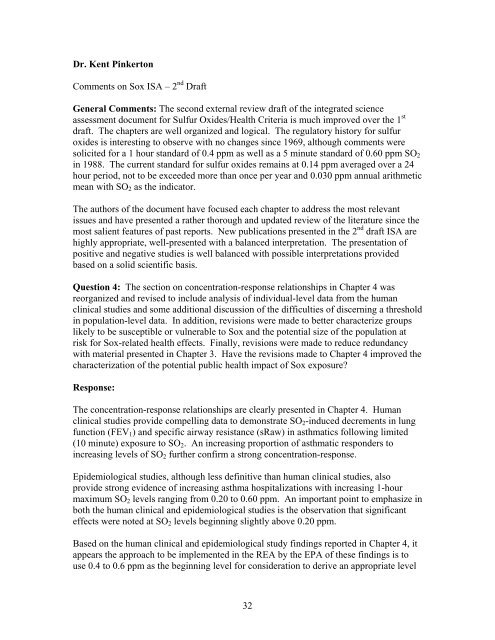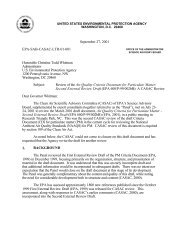(CASAC) Peer Review of EPA's Integrated Science Assessment
(CASAC) Peer Review of EPA's Integrated Science Assessment
(CASAC) Peer Review of EPA's Integrated Science Assessment
Create successful ePaper yourself
Turn your PDF publications into a flip-book with our unique Google optimized e-Paper software.
Dr. Kent PinkertonComments on Sox ISA – 2 nd DraftGeneral Comments: The second external review draft <strong>of</strong> the integrated scienceassessment document for Sulfur Oxides/Health Criteria is much improved over the 1 stdraft. The chapters are well organized and logical. The regulatory history for sulfuroxides is interesting to observe with no changes since 1969, although comments weresolicited for a 1 hour standard <strong>of</strong> 0.4 ppm as well as a 5 minute standard <strong>of</strong> 0.60 ppm SO 2in 1988. The current standard for sulfur oxides remains at 0.14 ppm averaged over a 24hour period, not to be exceeded more than once per year and 0.030 ppm annual arithmeticmean with SO 2 as the indicator.The authors <strong>of</strong> the document have focused each chapter to address the most relevantissues and have presented a rather thorough and updated review <strong>of</strong> the literature since themost salient features <strong>of</strong> past reports. New publications presented in the 2 nd draft ISA arehighly appropriate, well-presented with a balanced interpretation. The presentation <strong>of</strong>positive and negative studies is well balanced with possible interpretations providedbased on a solid scientific basis.Question 4: The section on concentration-response relationships in Chapter 4 wasreorganized and revised to include analysis <strong>of</strong> individual-level data from the humanclinical studies and some additional discussion <strong>of</strong> the difficulties <strong>of</strong> discerning a thresholdin population-level data. In addition, revisions were made to better characterize groupslikely to be susceptible or vulnerable to Sox and the potential size <strong>of</strong> the population atrisk for Sox-related health effects. Finally, revisions were made to reduce redundancywith material presented in Chapter 3. Have the revisions made to Chapter 4 improved thecharacterization <strong>of</strong> the potential public health impact <strong>of</strong> Sox exposure?Response:The concentration-response relationships are clearly presented in Chapter 4. Humanclinical studies provide compelling data to demonstrate SO 2 -induced decrements in lungfunction (FEV 1 ) and specific airway resistance (sRaw) in asthmatics following limited(10 minute) exposure to SO 2 . An increasing proportion <strong>of</strong> asthmatic responders toincreasing levels <strong>of</strong> SO 2 further confirm a strong concentration-response.Epidemiological studies, although less definitive than human clinical studies, alsoprovide strong evidence <strong>of</strong> increasing asthma hospitalizations with increasing 1-hourmaximum SO 2 levels ranging from 0.20 to 0.60 ppm. An important point to emphasize inboth the human clinical and epidemiological studies is the observation that significanteffects were noted at SO 2 levels beginning slightly above 0.20 ppm.Based on the human clinical and epidemiological study findings reported in Chapter 4, itappears the approach to be implemented in the REA by the EPA <strong>of</strong> these findings is touse 0.4 to 0.6 ppm as the beginning level for consideration to derive an appropriate level32
















